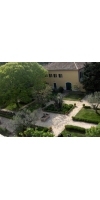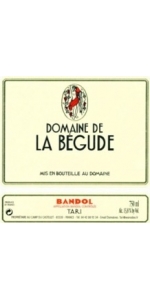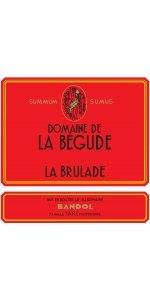Wine from Begude

Domaine de la Bégude
Domaine de La Begude was founded in 1996 by Guillaume and Louis Tari who continue an old family wine tradition (Chateau Giscours, 3rd Cru, Margaux). They are devoted to elaborating wines that express the characteristics of the Bandol terroir. The ageing cellars are the ancient Merovingian chapel of the 7th century from the "Conil" seigneury. This village has since disappeared, but it is mentioned as early as 966 in Saint Victor's maps. The estate produced some wine in the 16th century, and some ancient vinification tanks have been discovered there.
The Domaine de la Bégude Vineyard
The vineyard is situated at the top of the Bandol appellation (400 meters), overlooking the Mediterranean sea. The estate measures 1,240 acres of which 37 acres are in vines (15 hectares). The vines are cultivated on terraces facing south. The terraces are divided because of the very uneven relief of the wooded massif on which lies the estate. Olive trees surround most of the vine plots and take part in perfecting a typical landscape of the Bandol area.
The grape percentages are: 65% Mourvèdre, 25% Grenache,10% Cinsault, and the vines average 20 years of age. Grapes are hand harvested and totally de-stemmed before 3 – 4 weeks of fermentation on the skins. Egg white fining finishes the winemaking process before bottling. Production in total is 2,500 – 3,000 cases annually. This property makes clean and focused Bandol, as opposed to the rustic style so commonly seen from this A.O.C.
The Tari family also produces a Cotes de Provence (Rose and Red) made from grapes grown in the heart of the Provencal oak forest, dominating the Maures Mountains.
Begude Bandol Rouge is made from 90% Mourvèdre, 10% Grenache.
Eye: dark ruby colored
Nose: Intense, aromatic, fresh and elegant
Mouth: Structured on black fruits flavors, lightly woody , tanins are strong an firm in their early days (<5years) Good acidity give freshness backbone and great fruit/alcoholic balance . Delicate final on spices.
Opening: Decant 4-6 hours before serving
Soil: Clay-limestone Culture: Organic without pesticides nor chemicals additives Yield: 20 hectoliters/hectare Harvest: Manual in small cases Winemaking: Double sorting, 100% destemming, skin contact, with daily sticking in order to optimize color and aromatic extraction Alcoholic fermentation 15 days followed by malo lactic fermentation. Aging: 18 months in oak cask Bottling:
Grilled lamb, meat cooked with sauce, southern French cuisine and tasty dishes (tajines, couscous, paellas).
Review:
"Inviting spicy oak, malt and blackberry cream scents. Powerfully structured tannins, spicy liquorice and clove flavours as well as bramble fruit; very long finish. Its best years are far into the future. Terrific stuff."
- Decanter World Wine Awards 2020, 97 pts & Platinum Medal
Begude Bandol Rouge La Brulade is made from 95% Mourvedre and 5% Grenache.
"La Brulade" is the name of a select slope located at an altitude of 400 meters overlooking the Mediterranean sea between La Baie d'Amour (the town of La Ciotat) in the South and La Sainte Baume in the North. This is one of the highest parcels in the Bandol appellation.
The wine is only produced in exceptional vintages. This carefully selected blend is made of 95% Mourvedre and 5% Grenache, aged in large French oak barrels for 24 months.
The wine shows a deep purple color. It is fresh and fruity on the nose with intense garrigue aromas. Structured, elegant and well-balanced on the palate with strong tannins. Licorice, ripe black fruits, garrigue flavors and some peppery freshness on the finish.
The 35-year old grapes are grown on clay and limestone soils and are farmed organically. Yield is very low - 15hl/ha. The grapes are harvested manually.
Winemaking: Double selection, destemming, crushing before skin contact fermentation. No filtration. Aging for 24 months in French oak casks (600L).
Grilled meat (lamb, beef, boar), Mediterranean cuisine, spicy dishes.
Review:
"Complex nose with deep black berry fruits, spice and hints of polish. Really lovely texture with layers of creamy red and black fruits, spices and powerful but super fine tannins. Great expression of the appellation; powerfully long."
- Decanter World Wine Award 2020 - 97 pts & Platinum Medal
- back
Selected Options
Wineries
Categories
Pricing
Countries
Regions
Grape Types
Wineries
Organic/Free Shipping
Pago de Carraovejas Cuesta Liebres is made from 100% Tinto Fino. The plot is located on a terraced hillside located at 900 m above sea level with slopes that range between inclines of 30% and 40%. Red cherry color with purple hues. Ripe fruit aromas, vanilla notes. Suave and unctuous in the mouth. A strong and noble character.
The harvest is carried out by hand using small crates and after passing through a refrigerated container it is transferred into tanks via gravity. The alcoholic and malolatic fermentation is carried out in small French “Haute Futaie” Oak casks with unique and original local yeasts and fermenting bacteria from the vineyard itself, to bring out the very best of the terroir, respecting the uniqueness of each and every vintage. Clarified with egg whites and bottled by gravity with natural cork stoppers.
Pago de Carraovejas Cuesta de las Liebres 2019 is a red wine that masterfully blends finesse with a robust flavor profile. Upon olfaction, it unveils a complex array of nuances, with blueberries and blackberries taking center stage, complemented by undertones of sweet spices and hints of graphite and chocolate. On the palate, it is rich and full-bodied. This red wine boasts silky tannins, an extensive and enduring finish, and the exquisite signature of an outstanding vintage.
Luis XIV Brisat Orange Wine is made from 100% Merseguera.
Produced from old vines Marseguera (Gobelet / bush vines) with no irrigation and planted at 540 meters of altitude.
Intense yellow color, with orange reflections. On the nose it is very intense, with floral and fruity sensations reminiscent of a Mediterranean garden. In the mouth it has good tension, with medium tannins and very persistent aromas. Fine tannins.
It is a very intense white wine, which perfectly accompanies meat or fish-based rice dishes from Alicante, as well as different stews and seafood tapas.






